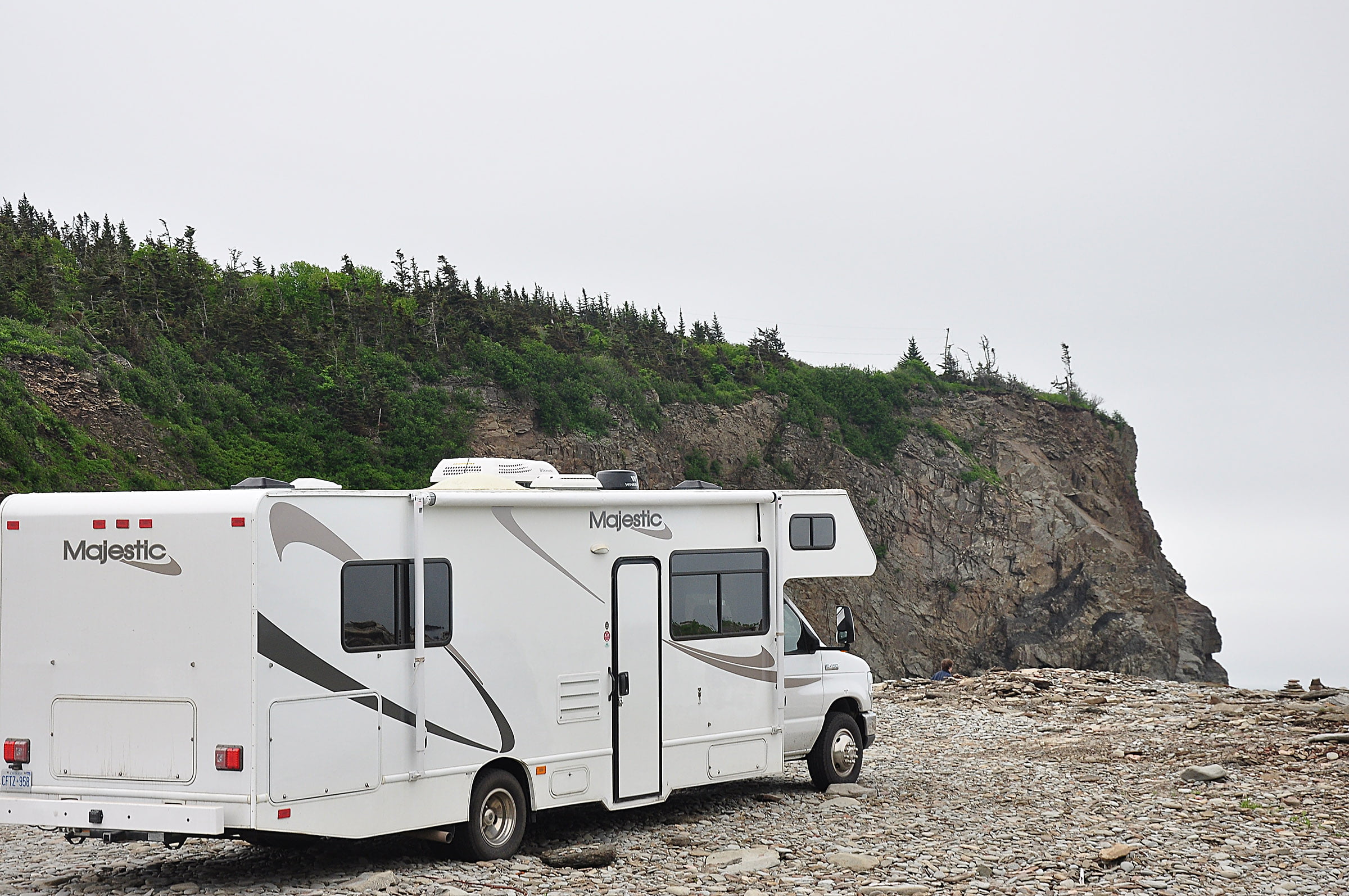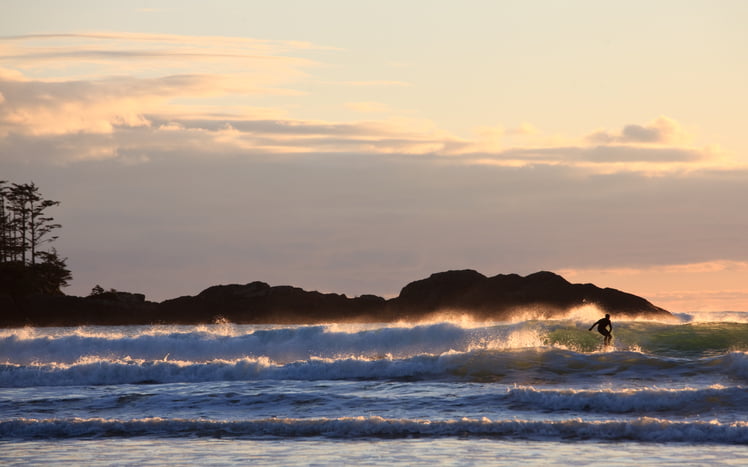New Brunswick is rich in hands-on experiences with natural wonders and beauty along the shores of the Bay of Fundy. The Bay of Fundy tides is the highest on the planet at 53 feet vertical in the Minas Basin at the closed end of the bay. They are an unspoiled marine wonder with more water flowing in and out each day than the combined daily flow of all the rivers that empty into the world’s oceans.
The highs and lows of Fundy tides are caused by the narrowing and shallowing of the bay, which forces the tidal water to pile up higher against the shore. The Fundy tides perfectly synchronize with the Atlantic tides causing an oscillation effect. The Atlantic tides push them higher, just like driving a playground swing repeatedly makes it go higher.
Our trip along the Fundy shore included four great places to experience tidal phenomena. They are the tidal bore in Moncton, Hopewell Rocks, Cape Enrage and the St. Martin Sea Caves.
Moncton Tidal Bore
In Moncton, we parked our motorhome in the free parking lot at Riverfront Park near downtown Moncton. It was a great spot to spend the day at no cost and enjoy the Petitcodiac River waterfront. There is an extensive trail system for kilometres in both directions along the river, great for hiking, biking, dog walking and nature observation along the river. I was riding my bike along this trail with our dog, a Brittany spaniel, trotting along in front of me. She slammed to a stop and went rigid like a statue pointing to the weeds at the trail’s edge. Out of the weeds at our feet flew up a beautiful ring-necked pheasant, trailing its long tail feathers.
But the most significant feature of the waterfront is the tidal bore that moves up the river as tidewater moves into the Bay of Fundy, into which the Petitcodiac River dumps. Tidewater coming upstream collides with the river water flowing downstream, producing a tall standing wave that marches relentlessly upstream. Adventurous types can surf the wave on high tides as it spills and tumbles its way upstream.
Our timing didn’t coincide with a full moon and the highest tide, but the tidal bore was still impressive if you want to see the most significant tidal effects, time your visit to the Bay of Fundy area with a full moon.
The timing of high and low tides each day can be found here. You can enter the location you will visit in the site window on this web page. There are only six hours and thirteen minutes between high and low tide each day, so you can do other things nearby while waiting for a low or high tide.
Because we stayed so long enjoying the riverfront and downtown Moncton, we didn’t feel like looking for an RV park for the night. We opted to dry camp in a nearby Walmart parking lot. We usually are ok with Wal-Mart’s, but the Moncton store has a lot of busy roads nearby with all-night traffic, so it was too noisy for us. Learn from us and get a campsite nearby if you stay overnight near Moncton.
Hopewell Rocks
About an hour south of Moncton is Hopewell Rocks Park – the iconic New Brunswick tourist site. These unique rock formations are on the ocean floor. Carved by the tidal water moving in and out twice a day is worth seeing. Coordinate your visit with low tide so you can walk on the ocean floor among the towering, flowerpot-shaped rocks. Or you can spend the better part of a day there and explore hiking trails, lookouts, sandy beaches, a restaurant and the interpretive centre while you wait for the tide to go out. Then descend the stairs to the sea bottom. Park staff remain on-site to answer questions and clear the waterfront when the wave comes back in. A shuttle included in your admission will take you down to the waterfront from the interpretive centre, or you can walk a paved trail down if you want some exercise. There is also a guided sea kayak tour if you wish to paddle among the giant flowerpots at high tide.

While the Hopewell Rocks site is impressive, it is highly regulated regarding how far you can explore. Cape Enrage, the next stop on the tidal wonder tour, allowed for personal adventure and discovery on a broad scale.

Cape Enrage
Cape Enrage is likely a mispronunciation of the original French name ‘Cap Enrage.’ This point of land is known for turbulent, raging water caused by a shallow shoal stretching nearly a kilometre offshore. The surface water at half tide, combined with strong tidal currents and opposing winds, creates large breakers and rough seas.

A scenic and twisty secondary road got us there in several hours from Hopewell Rocks. The road comes down a big hill to a beautiful vista of Barn Marsh Beach. We parked the RV and explored an expansive shoreline of smooth flat rocks. As the tide receded before our eyes, it exposed a lovely beach of soft sand. It was a great spot to explore sea life and check out an immense variety of polished sea stones and shells surrounded by towering rocky cliffs. The gentle grade of the sea bottom makes it a fine place to see the horizontal effect of the Fundy tides as two hundred meters of sandy beach are exposed at low tide.
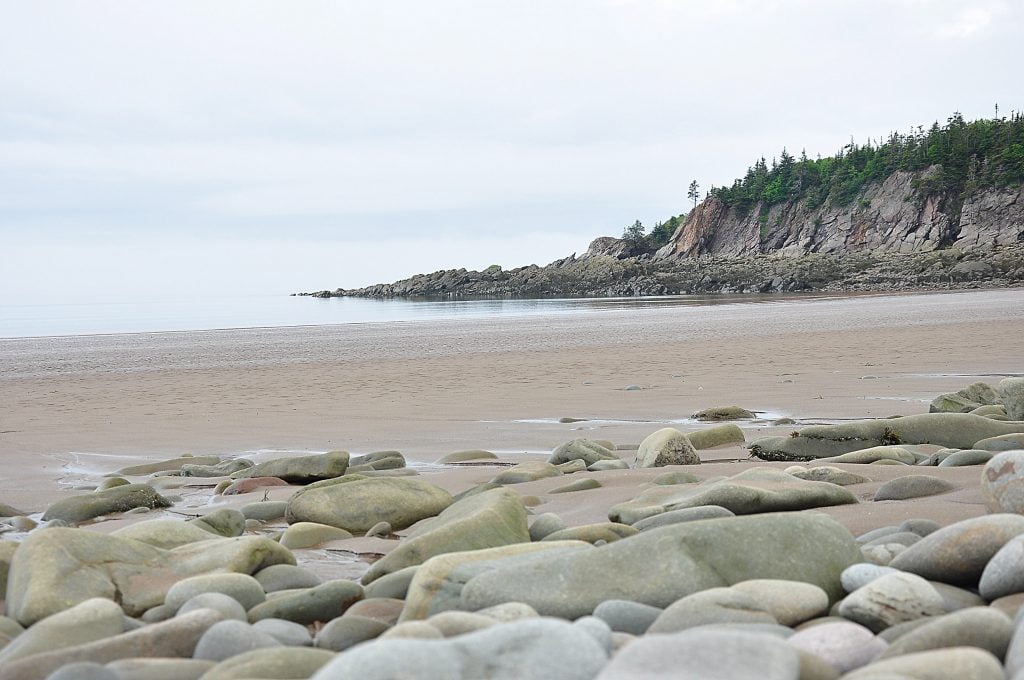
A five-minute drive from there up a steep switchback road brought us to the cliff-top interpretive centre, lighthouse and restaurant at Cape Enrage. At low tide, we descended a long staircase bolted to the cliff face to the exposed sea bed. This is the wildest and most unregulated walk on the seafloor you can experience. The rocky beach is five kilometres long, so you can explore as much or as little as you can handle. It’s a rare and thrilling experience to stand on the sea floor at the base of 40-metre cliffs above you.
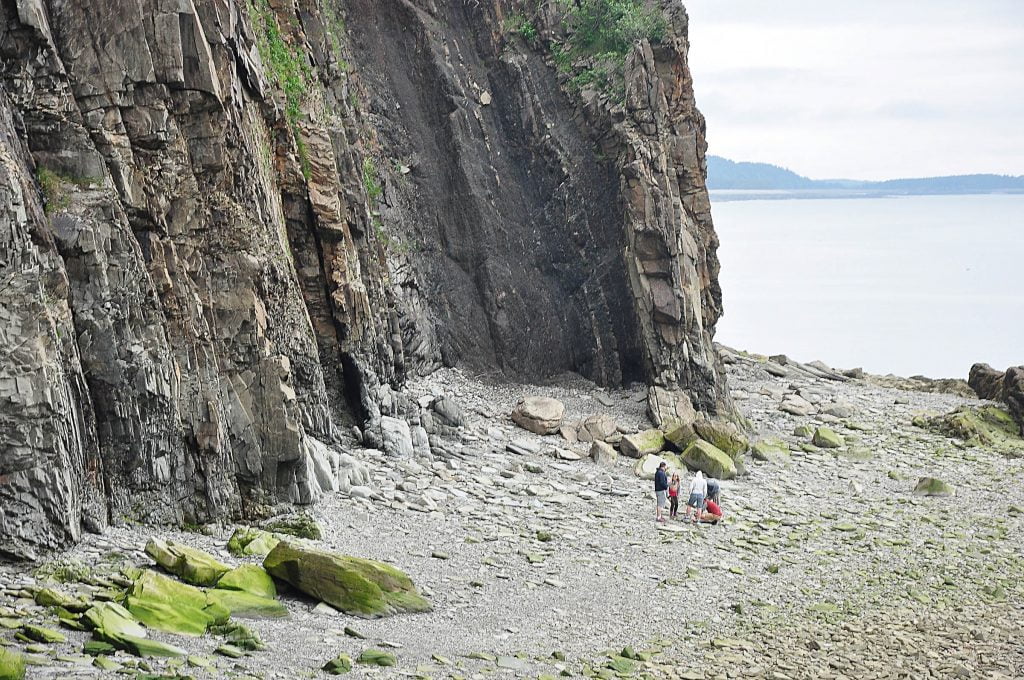
Although nothing can be removed, it is a beachcomber’s delight to look for and observe small sea life and shells in the tidal pools. Fossils are also common in the rocks that have fallen off the cliffs or are still embedded in the cliff face. If you hike the beach any distance from the staircase, note when the tide will return because the stairs are the only way off the coast before high tide floods it again.
The Cape House Restaurant offers fine dining with a beautiful view of the rocky seascape from the deck and inside tables. The menu has a variety of unique and appealing dishes, making it quite popular for locals, day-trippers, and out-of-town tourists.
The lighthouse at the Cape is not open to the public for an inside tour as it is a working unit. The original lighthouse was completed in 1840 because the waters off Cape Enrage were treacherous on a busy shipping route in the age of sail, with many shipwrecks recorded.
Fog is a frequent occurrence here, and there is a working fog horn that activates at the first hint of fog. The horn is more of an electronic tone than a blast from a literal air horn. After several minutes it became white noise to us. We did not find it bothersome or painful to our ears unless we walked right up to the lighthouse.
The gift shop is well stocked with souvenirs and quality, practical wares. My wife, often fantastic, bought a hooded pullover sweater to keep the breeze and dampness out. She wears it frequently, and it has served her well showing little sign of wear nine months later.
There is a six-hundred-foot zip-line at the site for anyone who thinks it might be cool to soar over the Fundy coast. If that’s too tame for you, there is rappelling on ropes down the forty-meter cliff face. These adventures are available from mid-June to early September.
There are tent camping sites available at the park accessed by a hiking trail, but no serviced RV sites. When evening came, we weren’t ready to leave, and there were no RV campgrounds nearby. We hoped to see the sunrise over the bay in the morning. So I asked if I could dry camp overnight in the parking lot and pay the tent camping fee. The staff were pleased to allow this. We had a spacious parking lot to ourselves. At some time in the night, the fog horn came on, but it didn’t wake us or disturb our sleep. We woke at an average time after a day of activity in the fresh sea air.
The morning fog obscured the sunrise, but as the sun intensified and the fog diminished, the shore was bathed in a mystical light, making it all worth seeing again.
St. Martin Sea Caves
The picturesque seaside village of St. Martin is about a half hour from St. John on good secondary roads. The sea caves there can only be explored at low tide, so time your visit according to the tide table. They are impressive up close and worth the hike across the seabed to see them. We found the area had a full day of activities to explore before low tide, which occurred late in the afternoon on our visit.
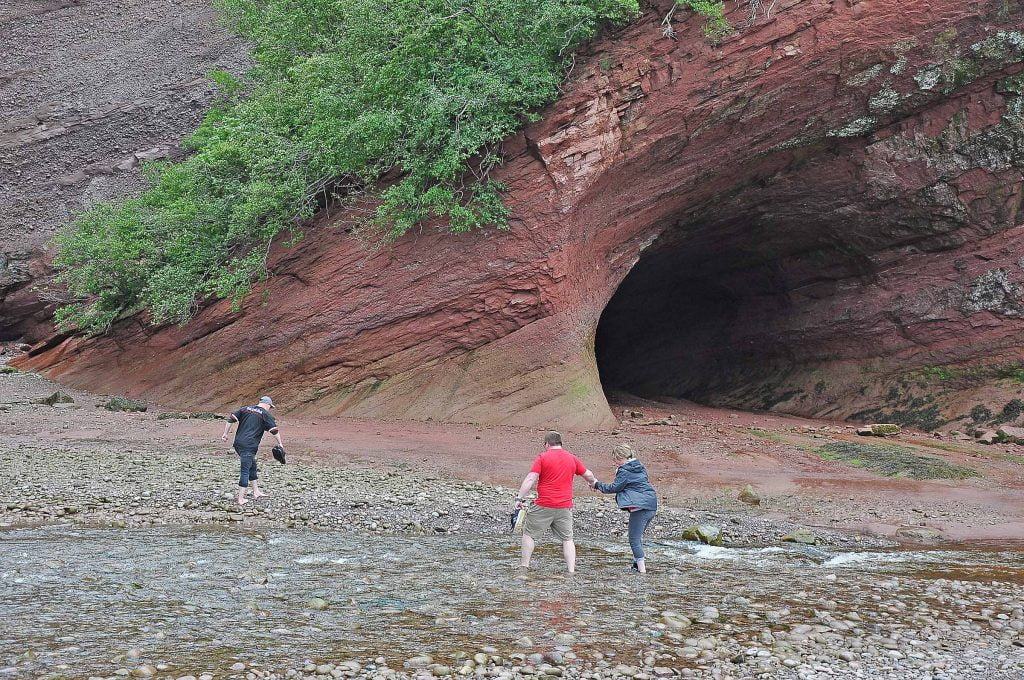
The Fundy Parkway, which begins ten kilometres east of St. Martins, is a sixteen-kilometre stretch of silky smooth, winding asphalt along the Fundy Coast that was a joy to drive in our motorhome. Along it, there are numerous lookouts for dramatic views of the rocky coastline sculpted by the extreme tides. I also took advantage of well-maintained hiking trails along the parkway. I biked on them with our dog trotting along under a cool canopy of sun-dappled leaves, which would periodically open up into sun-drenched vistas of blue sky, white-capped waters and jagged shorelines stretching off in the distance.
Stop at the Big Salmon River Interpretive Centre for a break on the parkway. Take in the displays and live presentations about the area’s local logging and shipbuilding heritage. Then hike over the suspension bridge across the river.
The historian in your group will love the Quaco museum on Main St. in St. Martins. The unpretentious building holds well-done and fascinating displays of the local shipbuilding heritage. Shipbuilding was the primary industry and brought great wealth to the area in the age of sail. Over five hundred ships were built and launched here over the years. It was amazing to see the skill, craftsmanship and knowledge that went into shipbuilding and launching by patient workers using hand tools.
The Quaco lighthouse, just ten minutes from St. Martins, has an amazing scenic view and is an excellent spot for a short rest or picnic. The town harbour merits a good walk around at low tide. Here you will see the vertical effect of the Fundy tides as the fishing fleet rests on the muddy seafloor fifteen feet or more below the dock level awaiting high tide to float it again. Near the harbour is a historic wooden covered bridge. It’s not open to traffic, but well worth a look.
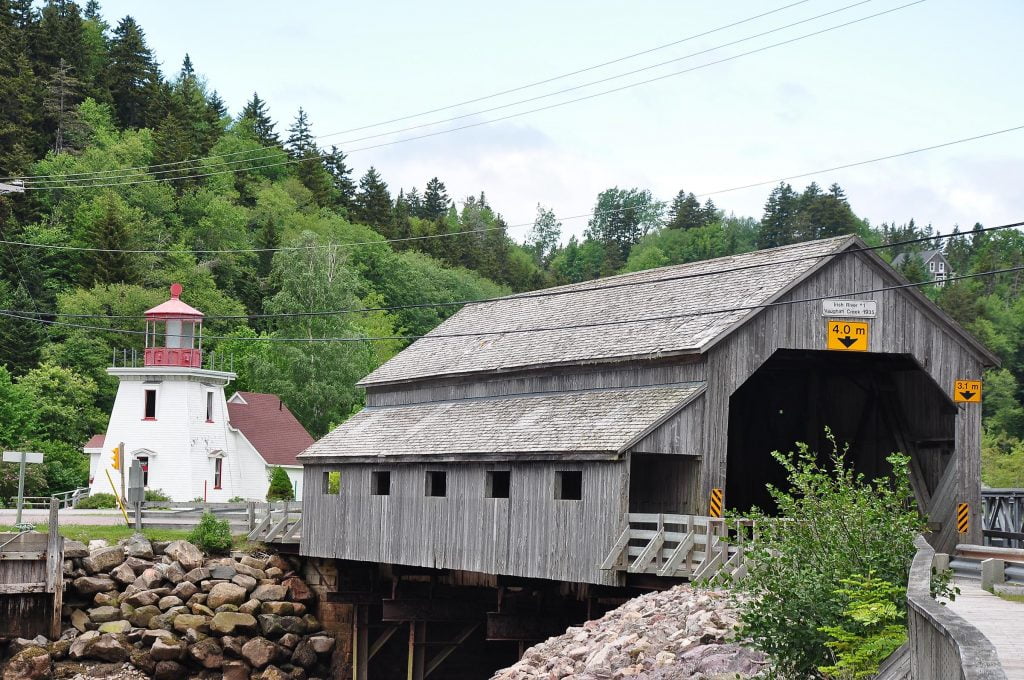
There was plenty to do while waiting for low tide to hike out to the sea caves. When the time came, we could park free along the road near the sea caves, and there was no charge to walk out to them. It’s a great value. Just put on sturdy footwear and go. They are massive caves carved out of sandstone cliffs by the daily tides. You will not get an accurate impression of their size and the power of the waves from the road. Make the hike. It’s worth it. Take your time and beach comb along the way if you like.
As we approached the caves, an ankle-deep freshwater creek flowed by in front of them. People remove their shoes to cross the stream or wear footwear they don’t mind getting wet and then proceed into the depths of the caves. It is truly a profound and unique experience to stand in a massive cave with seawater dripping off the rock around you and realize that in less than six hours, it will be filled with churning water again.
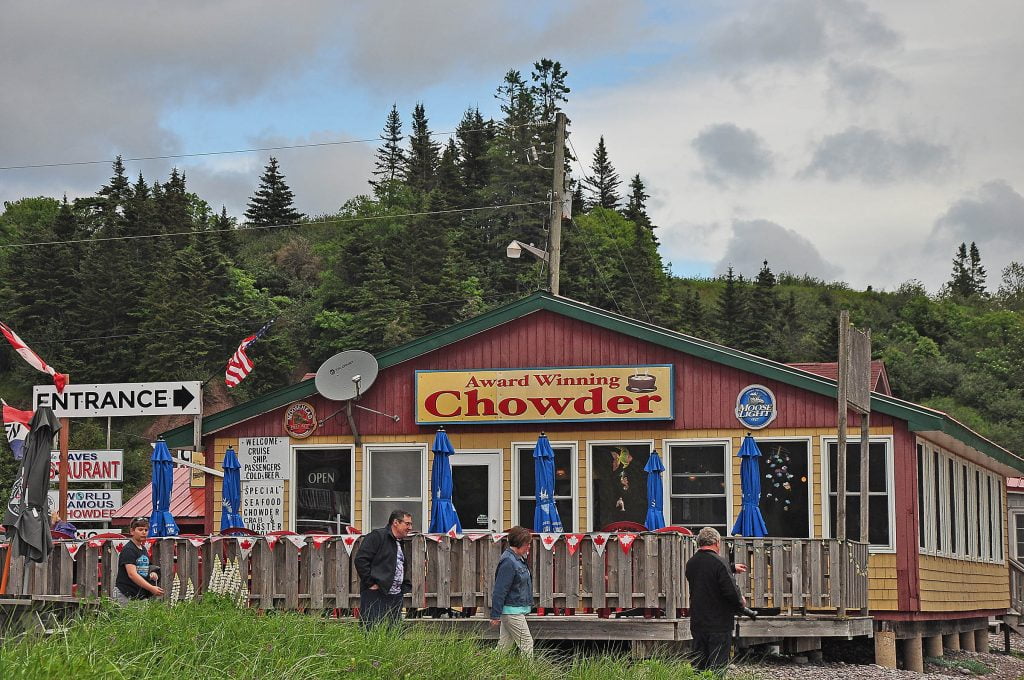
There is a great spot to eat near the caves, also. The Caves Restaurant boasts award-winning chowder. We wanted to try it, but the lineup for a table was right out the door and down the sidewalk. Fortunately, they also made up takeout, so we were enjoying our chowder on the beach in our lawn chairs in ten minutes. It was a warm evening with a refreshing sea breeze. In front of us on the beach, pet dogs frolicked, kids hunted for seashells, and sea glass and couples walked hand in hand in the gentle evening light. It was a great end to a full day of exploration.
If you want to overnight at St. Martins, three RV campgrounds are nearby. We liked the Fundy Shores Campground and Cottages for its nicely wooded setting. The sites were spacious, private and well-serviced.
The Bay of Fundy is pristine, powerful, and rugged. It’s 280 kilometres of craggy cliffs doing their best to contain 160 billion tons of seawater that flow in and out twice a day. From tidal bores to cliffs, caves, beaches and sea-going lore, it’s anything but a bore.

